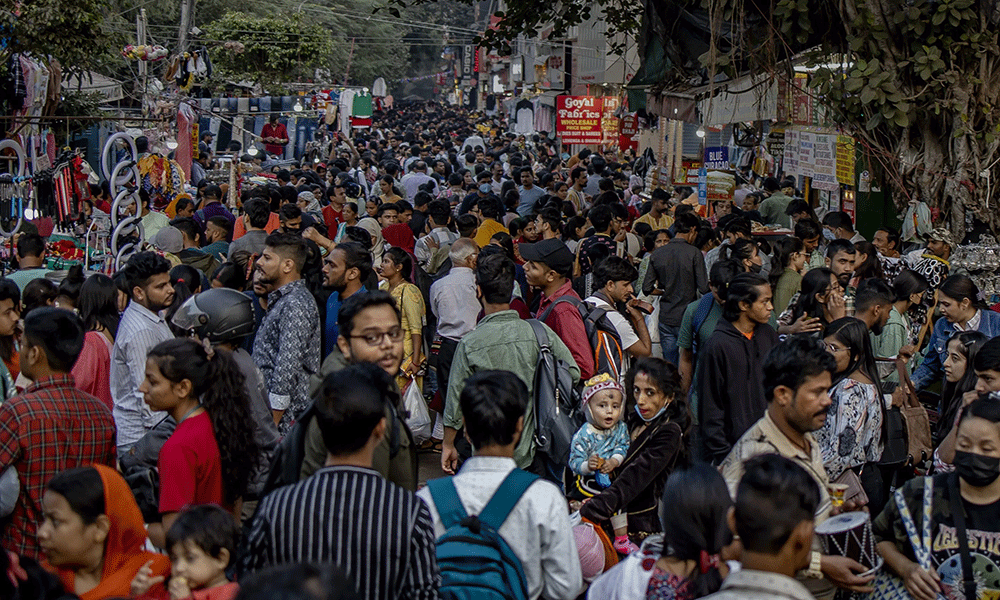
周二,中国政府宣布,由于新冠肺炎疫情时代的生育低谷期,中国人口几十年来首次减少,这一情况比预期提前到来。
这一消息极大地提高了人口结构转变的可能性:印度超过中国成为世界第一人口大国。
去年夏天,联合国预测印度将在2023年年中之前的某个时间点成为世界第一人口大国。
联合国预计2022年底,中国人口为14.26亿人,印度人口为14.22亿人,因此,中国仍是世界第一人口大国。联合国预测,到7月1日,两国将互换位置,印度人口将增长到14.29亿,中国人口将稳定在14.26亿。
然而,中国周二公布的2022年人口数据表明,中国人口下降速度比联合国预期的要快。联合国的模型预计中国人口将减少76000人。然而,根据中国国家统计局的数据,中国人口减少了85万,至14.16亿。
人口降幅超过预期,进一步缩小了中国和印度人口数量之间的差距,印度人口数量或已超过中国。

联合国经济和社会事务部没有立即回复《财富》杂志的置评请求。
印度人口预计什么时候会超过中国?
如果印度人口数量已经超过中国,那么过去对这一转变何时发生的预测就大错特错了。
2007年,中国专家预测,中国人口将在2033年达到15亿的峰值。在新冠肺炎疫情之前,联合国认为中印两国互换位置要到2027年才会发生。联合国在去年发布最新预测时,将预测日期提前至2023年,这是因为中国报告称,在整个疫情期间,新生儿数量迅速下降。
中国国家统计局周二也报告称,新生儿数量降至有记录以来的最低水平,死亡率略有上升。
印度有多少人口?
印度自2011年以来就没有进行过人口普查,当时该国报告的人口为12亿。人口普查原定于2021年进行,但印度政府将多次推迟人口普查的原因归咎于新冠疫情。
印度官方预测的人口数量没有联合国估计的那么多。该国国家人口委员会2020年的一份报告预计,到2022年3月和2023年3月,印度人口分别为13.76亿和13.88亿。根据估计,印度人口数量要到2026年才会超过中国现有人口数量。
但印度的官方估计可能低估了真正的人口数量,这是因为印度的贫困家庭和农村家庭通常不办理新生儿出生登记,使得用于估计人口规模的数据出现偏差。
中印两国在人口数量排名上正式互换位置后,两国之间的差距只会进一步扩大。联合国估计,到2050年,印度人口将激增至16.68亿。届时,中国人口将缩减至13.17亿。(财富中文网)
译者:中慧言-王芳
周二,中国政府宣布,由于新冠肺炎疫情时代的生育低谷期,中国人口几十年来首次减少,这一情况比预期提前到来。
这一消息极大地提高了人口结构转变的可能性:印度超过中国成为世界第一人口大国。
去年夏天,联合国预测印度将在2023年年中之前的某个时间点成为世界第一人口大国。
联合国预计2022年底,中国人口为14.26亿人,印度人口为14.22亿人,因此,中国仍是世界第一人口大国。联合国预测,到7月1日,两国将互换位置,印度人口将增长到14.29亿,中国人口将稳定在14.26亿。
然而,中国周二公布的2022年人口数据表明,中国人口下降速度比联合国预期的要快。联合国的模型预计中国人口将减少76000人。然而,根据中国国家统计局的数据,中国人口减少了85万,至14.16亿。
人口降幅超过预期,进一步缩小了中国和印度人口数量之间的差距,印度人口数量或已超过中国。
联合国经济和社会事务部没有立即回复《财富》杂志的置评请求。
印度人口预计什么时候会超过中国?
如果印度人口数量已经超过中国,那么过去对这一转变何时发生的预测就大错特错了。
2007年,中国专家预测,中国人口将在2033年达到15亿的峰值。在新冠肺炎疫情之前,联合国认为中印两国互换位置要到2027年才会发生。联合国在去年发布最新预测时,将预测日期提前至2023年,这是因为中国报告称,在整个疫情期间,新生儿数量迅速下降。
中国国家统计局周二也报告称,新生儿数量降至有记录以来的最低水平,死亡率略有上升。
印度有多少人口?
印度自2011年以来就没有进行过人口普查,当时该国报告的人口为12亿。人口普查原定于2021年进行,但印度政府将多次推迟人口普查的原因归咎于新冠疫情。
印度官方预测的人口数量没有联合国估计的那么多。该国国家人口委员会2020年的一份报告预计,到2022年3月和2023年3月,印度人口分别为13.76亿和13.88亿。根据估计,印度人口数量要到2026年才会超过中国现有人口数量。
但印度的官方估计可能低估了真正的人口数量,这是因为印度的贫困家庭和农村家庭通常不办理新生儿出生登记,使得用于估计人口规模的数据出现偏差。
中印两国在人口数量排名上正式互换位置后,两国之间的差距只会进一步扩大。联合国估计,到2050年,印度人口将激增至16.68亿。届时,中国人口将缩减至13.17亿。(财富中文网)
译者:中慧言-王芳
On Tuesday, Chinese authorities announced that the country’s population declined for the first time in decades, an event that came earlier than expected thanks to a COVID-era baby bust.
The announcement increases the chance that another long-expected demographic shift may have already happened: India overtaking China as the world’s most populous country.
Last summer, the United Nations projected that India would take the No. 1 position at some point before the middle of 2023.
The United Nations’ estimates for the end of 2022 still put China in first place, giving China 1.426 billion people and India 1.422 billion. The UN forecast that the two countries would have switched places by July 1, as India grows to 1.429 billion and China holds steady at 1.426 billion.
Yet the 2022 population China reported on Tuesday suggests a faster rate of decline than the UN expected. The UN’s model projected a drop of 76,000. According to the National Bureau of Statistics, China’s population instead shrunk by 850,000 to 1.416 billion.
A larger-than-projected decline narrows the gap between China and India’s populations, raising the possibility that India has already overtaken China in size.
The United Nations’ Department of Economic and Social Affairs did not immediately respond to a request for comment.
When was India forecast to overtake China in population?
If India has passed China in population, past forecasts of when the switch would happen were wildly off.
In 2007, Chinese experts predicted that the country’s population would peak at 1.5 billion in 2033. Before the pandemic, the UN thought the swap wouldn’t happen until 2027. When it released updated projections last year, UN moved its projected date forward to 2023 as China reported a rapid decline in new births throughout the pandemic.
China’s National Bureau of Statistics also reported on Tuesday a fall in new births to the lowest level on record and a slight uptick in death rates.
What is India’s population?
India has not conducted a census of its population since 2011, when it reported a population of 1.2 billion. A count was scheduled for 2021, but New Delhi has postponed the census several times, citing the COVID pandemic.
India’s official forecast doesn’t put its population as high as United Nations estimates. A 2020 report from the country’s National Commission on Population projected populations of 1.376 billion and 1.388 billion for March 2022 and March 2023 respectively. Based on those estimates, India wouldn’t overtake China’s current population until 2026.
But India’s official estimates are likely to be an undercount, since poor and rural households in India often don’t register new births, skewing the data used to estimate population size.
The gap between India and China will only grow after the two countries officially switch places on the population rankings. The UN estimates that India’s population will swell to 1.668 billion by 2050. China’s population, by then, will shrink to 1.317 billion.






